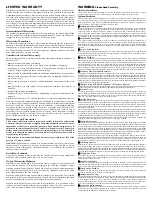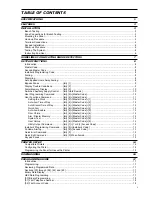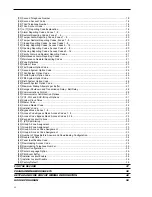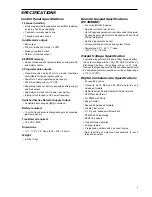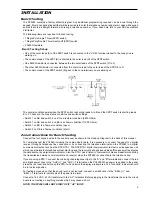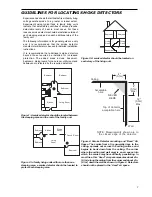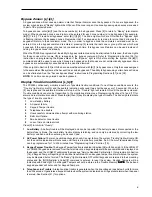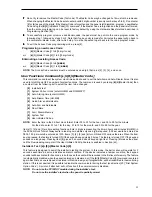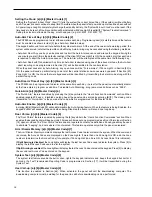
5
If no siren or bell is used, connect a 1000
Ω
resistor between BELL [+] to BELL [-]. The bell/siren alarm output is pulsed
(1 second ON 1 second OFF) when an alarm is created by the [F] keypad zone, by the FIRE zone, or when the Bell
Pulse option is enabled in Section [21] Zone Light 6. The Bell output can also be programmed to be inverted; refer
to Programming Section [21] Zone Light 7.
Keypad Terminals: RED, BLK, YEL and GRN
Connect the four colored wires from the keypads to these terminals. When connecting more than one keypad, connect
in parallel across the keypad terminals at the control panel (i.e. all reds together, all blacks together, all yellows together
and all greens together). The keypad red and black power supply terminals are fused through the auxiliary fuse.
Programmable Outputs: PO1, PO2, PO3 and PO4
The PC2585 provides 4 programmable outputs. The operation of PO1 and PO2 depends upon which option is selected
in the programming table. See the Programming Section [31]. PO3 and PO4 can be programmed for different
operations in the “Third System Option Code” Section [22]. Terminals PO1 to PO4 are 50mA maximum switches to
ground. A 100 Ohm current limiting resistor is connected in series. A small relay, a buzzer or other DC operated device
may be connected between the 12VDC “AUX+” (positive) terminal and any one of the “PO” (switched negative)
terminal on the main board.
Auxiliary Input Terminal: AUX IN (also Key Arming)
The “AUX IN” input terminal is a normally open 24-hour zone. It can be programmed from the keypad to be silent or
audible. There is no display on the keypad for the “AUX IN” input. An alarm on this input is created by applying a positive
voltage or by closing a contact between the “AUX IN” terminal and the positive auxiliary supply. See “Programming
Guide [
Q
][8]” Section [15] for programming the alarm and restoral codes.
The “AUX IN” terminal can also be used as a momentary key arming/disarming input. See “Programming Guide”
Section [31] for a list of options for the “AUX IN” terminal.
Zone Input Terminals Z1 to Z8
Zone inputs Z1 to Z8 are supervised Double End Of Line resistor circuits. Double E.O.L resistor circuits give zones
the capability to detect tamper conditions. A tamper condition can be either a short or open on a zone. The normal
condition is 5600 Ohms. The Alarm condition is 11200 Ohms. The tamper resistor is placed between the tamper
contact and the alarm contact. This configuration will allow the panel to detect zone tampers (zone open or shorted),
zones in alarm (alarm condition of 11200 Ohms), and restored zones (normal condition of 5600 Ohms). See the
Hook-up Diagram for normally closed and normally open contact connections.
Telephone Terminals: A, B, C, D, and EGND
The wires from the RJ31-X telephone jack are connected to these terminals in the following way.
A
Red wire from RJ31-X cord
Incoming line from
B
Green wire from RJ31-X cord
telephone company
C
Grey wire from RJ31-X cord
Outgoing line to
D
Brown wire from RJ31-X cord
house telephone(s)
Battery Connections
Do not connect the battery or the transformer until the wiring is complete. Connect the red battery lead to the positive
battery terminal and the black lead to the negative battery terminal. If the connection is made in reverse the battery
fuse will blow. The battery charging voltage is factory set and normally needs no adjustment.
Summary of Contents for PC2585
Page 55: ......


